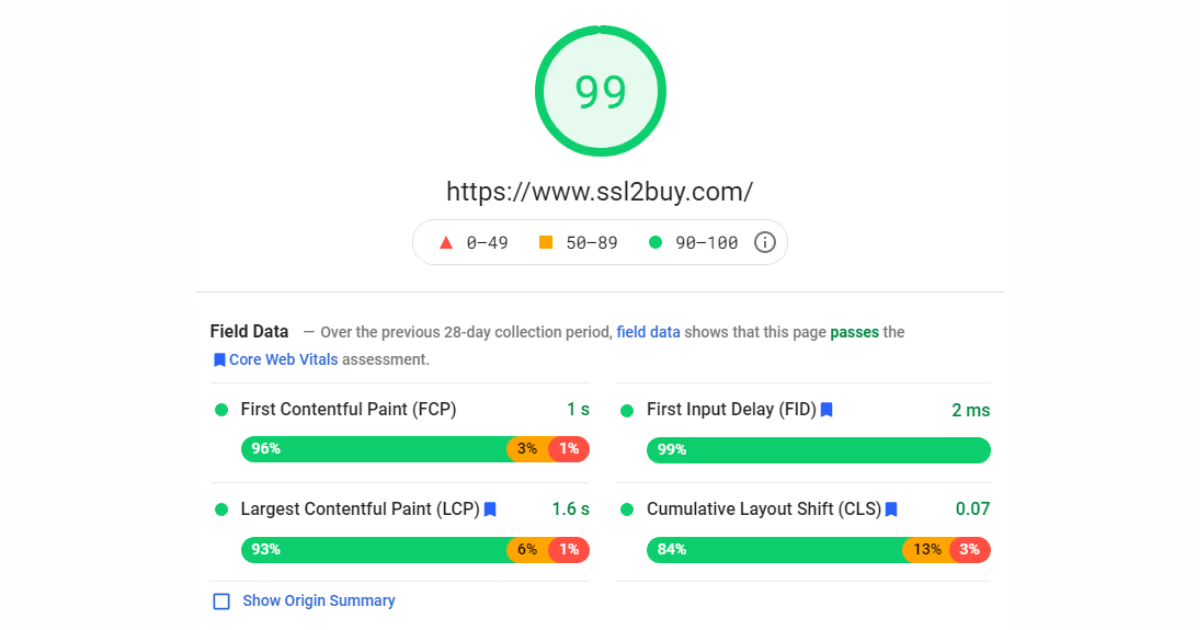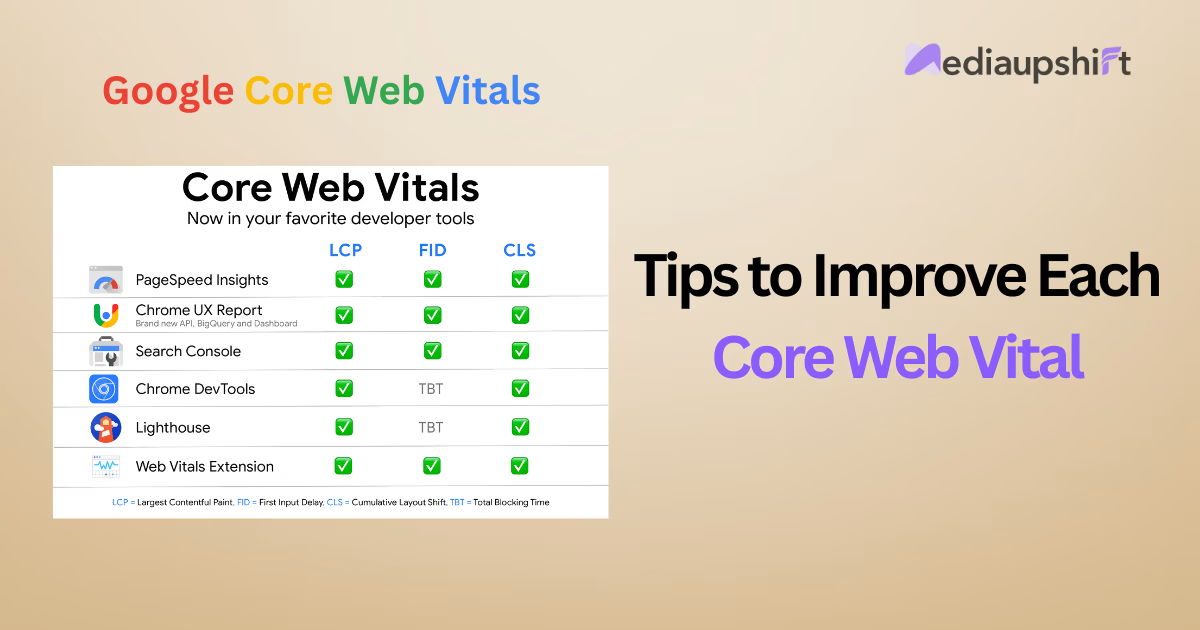How to Improve Your Core Web Vitals for SEO Success
Published on: 18 Aug, 2025

SEO is no longer just about keywords and backlinks, but also about how your site feels to users who visit. If your website is loading slowly or takes forever to respond, then it can lead to users leaving it, and Google notices that, and that’s where Core Web Vitals are needed.
These are a set of performance metrics from Google that focuses on real-world user experience, like checking on the loading speed, visual stability, and responsiveness of your website. In this blog, we’ll cover what Core Web Vitals really are, why they matter, and how you can use it to boost both your SEO and user satisfaction.
What Are Core Web Vitals?
Core Web Vitals are a set of three major performance metrics that were introduced by Google as part of its Page Experience update, in which they emphasize on real-world user experience as a ranking factor. These metrics help you measure how any user perceives the speed, responsiveness, and visual stability of your website.
There are three key Core Web Vitals:
-
Largest Contentful Paint (LCP):
This metric measures the time it takes, specifically for the largest content element like an image, heading or a block of text on your page to load and become fully visible in the user's device.
- Good website score ≤ 2.5s
- Needs Improvement ≤ 4s
- Poor website score > 4s
-
First Input Delay (FID) or Interaction to Next Paint (INP):
INP metric tracks how quickly your website responds to a user's interactions like clicks, taps, or key presses throughout the entire user session.
- Good website score ≤ 100ms
- Needs Improvement ≤ 200ms
- Poor website score > 200ms
-
Cumulative Layout Shift (CLS):
CLS metric measures the amount of unexpected layout shifts and visual stability on your page during loading. Unexpected layout shifts can sometimes be disruptive and frustrate the users.
- Good website score ≤ 0.1
- Needs Improvement ≤ 0.25
- Poor website score > 0.25
- User Experience (UX): Strong Core Web Vitals lead to a smoother, faster, and more enjoyable experience for users on your website, which can result in increased engagement.
- SEO Ranking: Google specifically uses Core Web Vitals as a ranking factor in its search algorithm and so, websites that meet the recommended requirement for these metrics are more likely to rank higher in search results.
- Google PageSpeed Insights: Analyzes any URL and provides lab and field data (real-user metrics). It also breaks down each Core Web Vital and gives you clear suggestions that would help you improve performance.
- Google Search Console (Core Web Vitals Report): This tool shows how your pages perform for actual users over a span of time, highlighting URLs that need improvement based on field data collected from Chrome users.
- Lighthouse (in Chrome DevTools): This is a very useful performance auditing tool for developers that help you access and measure your page’s performance in a controlled environment that also gives you technical advice in areas of improvement.
- Web.dev & Chrome UX Report (CrUX): These platforms help give you broader insights into the user-centric metrics from a public dataset that allows you for an even deeper evaluation.
- Compress your images so that your page loads faster
- Use lazy loading for content that appears below the fold.
- Minimize any CSS or JavaScript that is blocking rendering.
- Choose fast hosting and use caching tools.
- Cut down on lengthy JavaScript tasks.
- Remove all the non-essential scripts.
- Use code splitting and load scripts asynchronously.
- Remove the third-party plugins that are not required.
- Always set dimensions for your images and videos.
- Reserve space for ads and embeds.
- Try not to add content dynamically above the fold.
- Use font-display to get rid of any flashes of invisible text.
- Optimize your Images: Compress images on the website and use modern formats like WebP, you can also use lazy loading for the images that are below the fold.
- Minimize JavaScript: You can delay non-essential scripts, remove unused code, and minimize the JavaScript files.
- Use a CDN: A Content Delivery Network (CDN) distributes your website's content across multiple servers and if you’re serious about speeding things up, you need to use a CDN. It’s like having multiple delivery drivers to get your content to users faster.
- Optimize CSS: Remove all the unnecessary CSS files, render-blocking CSS and inline critical CSS so that it renders faster.
- Enhance Server Response Time: You need to choose a reliable hosting provider, improve any kind of database queries, and reduce the server load.
- Avoid Large Layout Shifts: Specify the dimensions for the images and videos, keep some space for ads and embedded content, and use CSS aspect ratio boxes.
- Prioritize Visible Content: Make sure that the most important content should load quickly, like the heading and above the load content.
- Regular Monitoring: You can use tools like PageSpeed Insights and Chrome User Experience Report (CrUX) to track your Core Web Vitals scores and make any required adjustments or changes.
- Taking out too many features for speed can compromise user experience, so try to maintain a balance between performance, design, and functionality.
- If you forget about mobile performance and put all the focus on desktop metrics can surely harm your rankings as Google prefers mobile-first indexing.
- Ignoring field (real-user) data and fully depending upon lab data
- Site changes such as new themes or plugins can affect performance, so regularly audit your Core Web Vitals anytime there is a new update.
- Having too many third-party scripts or a very high number of scripts and widgets can slow down your website loading time, so only keep the functional ones.
These vitals reflect how smooth and user-friendly your site feels and optimizing them is crucial for both SEO and giving a great browsing experience.
Why Core Web Vitals Matter for SEO?

Core Web Vitals are officially Google ranking signals so if your site provides a quicker, more stable, and more responsive experience to the users, you will be more likely to rank higher on search.
These are the metrics that directly influence how any visitor would be able to use your site. A slow-loading page or a page that moves around during loading will frustrate anyone who comes to visit your site and might lead them to leave in a hurry. This results in increased bounce rates and very low conversion chances, both of which are indicators of bad user experience to search engines.
Having a smooth and responsive website actually helps a lot to increase user satisfaction, engagement, and trust. All of these contribute significantly to enhancing your SEO performance and can even result in increased conversion rates.
Why are they Important?
How to Measure Your Core Web Vitals
Before you can improve your Core Web Vitals, you need to know where you stand. And, thankfully, Google has provided several tools that will help you find out where your site stands and what you can improve. Don’t worry if some numbers look bad, that’s why we’re here!
Tips to Improve Each Core Web Vital

Largest Contentful Paint (LCP):
First Input Delay (FID) or Interaction to Next Paint (INP):
Cumulative Layout Shift (CLS):
Additional Technical SEO Practices to Support Core Web Vitals
Improving the Core Web Vitals needs more than just changing a few speed settings, it should have a strong knowledge of technical SEO. Here are some of the key strategies that will support and enhance your site’s performance:
Common Mistakes to Avoid
Here are some very common mistakes that you need to avoid when you’re trying to improve your Core Web Vitals:
Avoiding these mistakes will ensure that it genuinely improves the overall performance of your website without compromising the user experience or long-term SEO results.
Conclusion
Core Web Vitals have become a very important part for SEO success, and Google is also placing a strong focus on real user experiences. It checks how quickly your site loads, how stable it feels, and how fast it reacts to user actions. By measuring the Core Web Vitals, which include LCP, FID (or INP), and CLS, you’re not just improving your rankings, but also providing a smoother and much better experience for your users.
Always remember that a nicely performing website is a win-win for the users as well as search engines. Enhancing Core Web Vitals helps you improve performance by regular tracking, maintenance, and teamwork. Stay proactive, keep testing, and treat performance as a long-term SEO initiative.
Frequently Asked Questions
1. What are Core Web Vitals?
Core Web Vitals are performance metrics that measure the loading speed, responsiveness, and visual stability of your website to provide a better user experience.
2. How do Core Web Vitals impact SEO?
Google uses Core Web Vitals as ranking signals. A smoother website experience can improve SEO, user engagement, and conversion rates.
3. How can I measure Core Web Vitals?
Use tools like Google PageSpeed Insights, Lighthouse, and Search Console to track and analyze your website’s performance metrics.
4. What is the ideal score for LCP?
The ideal Largest Contentful Paint (LCP) score is ≤ 2.5 seconds. If your website scores more than 4 seconds, it surely needs improvement.
5. What are common mistakes when improving Core Web Vitals?
Avoid removing too many features, neglecting mobile performance, or fully depending on lab data when you’re optimizing Core Web Vitals.